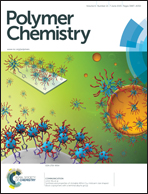A low band-gap copolymer composed of thienyl substituted anthracene and diketopyrrolopyrrole compatible with multiple electron acceptors for high efficiency polymer solar cells†
Abstract
A low band-gap copolymer consisting of 9,10-thienyl-substituted anthracene (TA) as an electron-donating unit and diketopyrrolopyrrole (DPP) as an electron-withdrawing unit has been synthesized and applied to the donor material in polymer solar cells. The weak electron-donating characteristic of TA, which has 2-D extended conjugation by thiophene side groups, makes the copolymer exhibit a low-lying HOMO level of −5.5 eV with a low band-gap of 1.65 eV, which affords both high photo-voltage and photo-current of the polymer solar cells. As a result, the solar cell device fabricated from the blend of the copolymer and PC71BM exhibits a promising power conversion efficiency of 7.02% (VOC = 0.80 V, JSC = 13.1 mA cm−2, FF = 0.67). Moreover, the polymer solar cell as fabricated from the blend of the copolymer and di-perylene bisimide (di-PBI) as a non-fullerene electron acceptor exhibits a promising power conversion efficiency of 4.23% with VOC = 0.77 V, JSC = 9.8 mA cm−2, and FF = 0.56. This photovoltaic performance of the copolymer not only demonstrates that the TA is a promising electron-donating building block for a high performance low band-gap copolymer, but also the copolymer is compatible with both PC71BM and a non-fullerene acceptor for high efficiency polymer solar cells.


 Please wait while we load your content...
Please wait while we load your content...